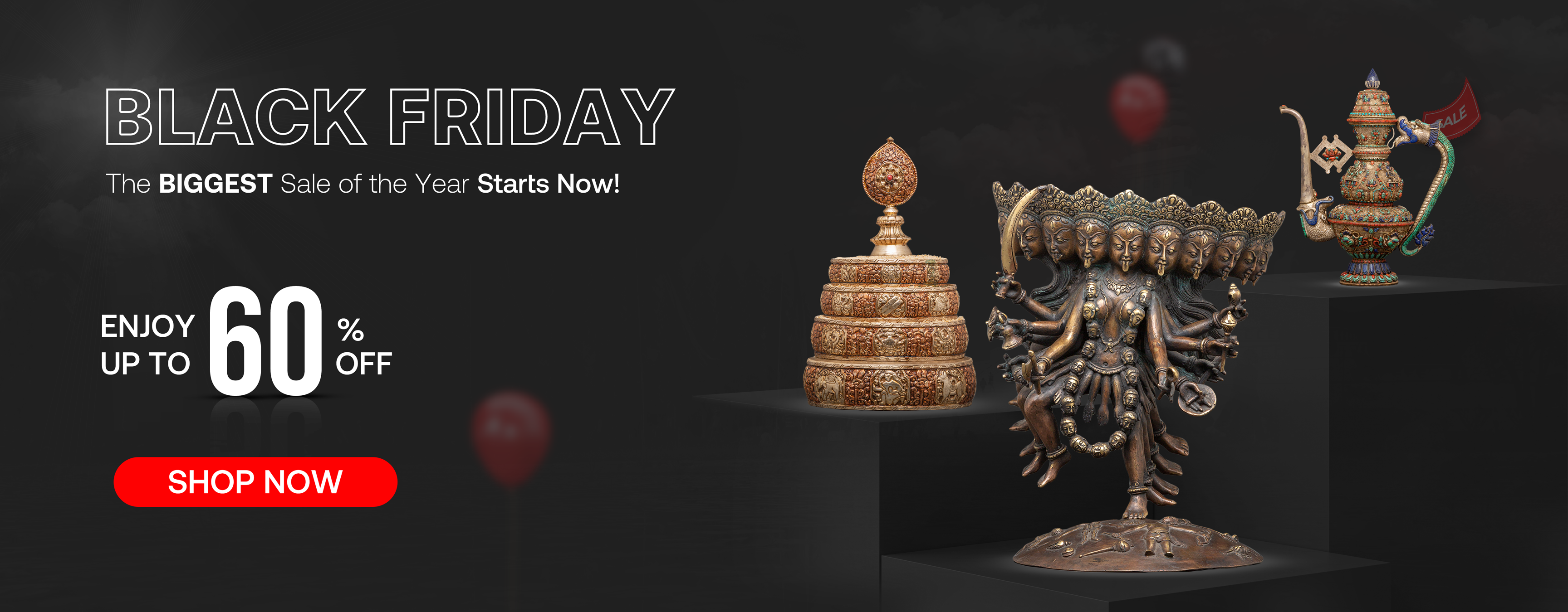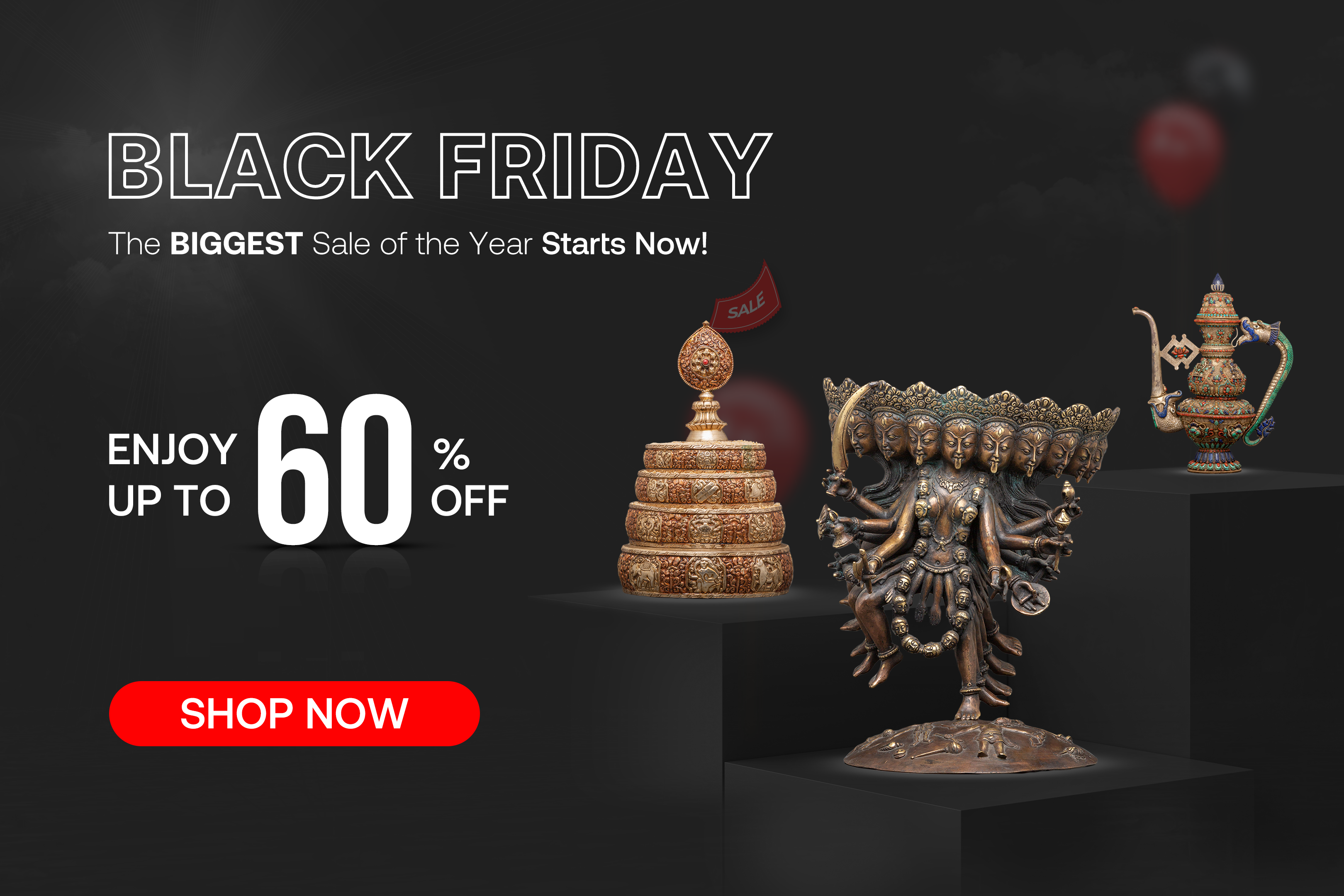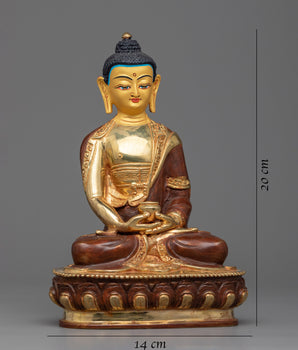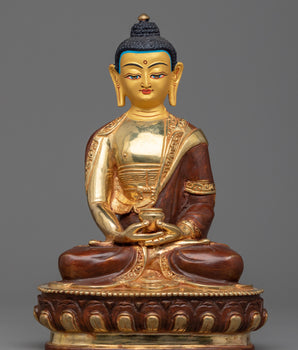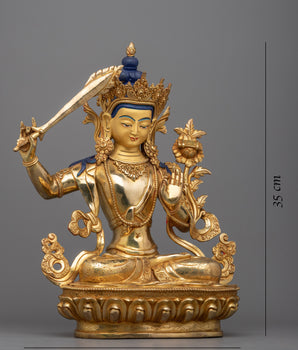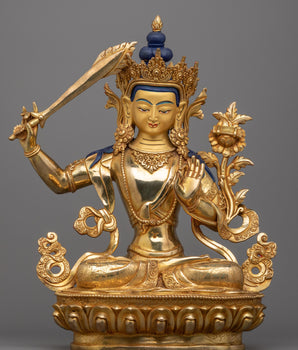Ghau Boxes Are Integral to Tibetan Buddhism
The Ghau (also spelled Gau) is a profound symbol of faith, protection, and connection to the divine in Vajrayana Buddhism and the broader Himalayan spiritual traditions. This sacred amulet box has held deep religious and cultural significance for centuries, embodying the essence of Tibetan spirituality and devotion. Whether worn as a necklace or carried as a pocket shrine, the ghau acts as a portable vessel of spiritual power, merging art with purpose.
In this read, we will delve into the meaning and importance of the Gau amulet, examining its role in Vajrayana Buddhism, its intricate design and craftsmanship, its multifaceted roles, and its enduring reverence in Tibetan culture today. Additionally, we will explore the sacred essence of the Ghau as a prayer box, which holds deep religious significance for its wearers and users.
What is a Ghau Amulet?
The Ghau (Gau, Gao, Ga'u, or Gawu) is a small, portable container or box often worn as an accessory. It holds sacred relics and votive offerings (Tibetan: Tsatsa, tsa-tsa, or tsha-tsha), traditionally carried by Tibetan Buddhists and other followers of Himalayan spiritual traditions. The primary purpose of the Gao is protection. Inside the box, one can find relics, mantras, sacred texts, and images of deities and revered masters, sacred pills (rilbu), all intended to provide blessings, spiritual protection, and healing to the wearer.
The design of a Ghau box can differ based on its owner, region, and intended use, but the fundamental concept is consistent: it serves as a small shrine that enables practitioners to carry the essence of the sacred with them at all times. Typically crafted from silver, gold, brass, or copper materials, the Gau is often embellished with detailed designs and carvings of the Eight Auspicious Symbols (Ashtamangala).
The eight auspicious symbols are also called "the eight symbols of good fortune in Buddhism," and they are listed below:
- The Precious Parasol
- White Conch Shell
- Two Golden Fish
- Knot of Eternity
- Vase of Great Treasures
- Victory Banner
- Lotus Flower
- Eight Spoked Wheel
Exploring the Ancient Origins of the Ghau Amulet
Ghau is essential to Tibetan Buddhism and the indigenous Bon tradition. Historically, these boxes served as portable reliquaries, enabling nomadic Tibetan communities to transport sacred pieces while traveling across the vast landscapes of the Himalayas. This portability allowed spiritual practices to continue without interruption, maintaining a constant connection to the divine. Over the centuries, the design and use of the Tibetan prayer have transformed, showcasing the dynamic relationship between religious devotion and everyday life. Initially, Gaus were simple containers, but as time went on, they became more intricate, embellished with detailed designs, and made from precious materials, representing both artistic creativity and profound spiritual meaning.
As Buddhism spread across the Tibetan plateau, the Gaos emerged as a significant element in the daily lives of spiritual practitioners as protective amulets (Tibetan: sungwa, sungkhor). It became a vital tool for meditation, prayer, and protection, acting as a personal relic box that contained sacred items like mantras, Dharanis, and images of Buddhas and Bodhisattvas. Furthermore, Gawu also evolved into a symbol of devotion and faith, worn by monks, lamas, and laypeople as a continual reminder of their spiritual journey.
The Sacred Contents of a Ghau Amulet
The Ghau amulet is a revered vessel that contains various sacred artifacts crucial to Tibetan Buddhism. Those contents are thoughtfully selected and consecrated, contributing significantly to the amulet's power to offer the wearer spiritual protection, blessings, and strength. Each element placed is thought to possess divine energy and spiritual importance, making the amulet a vital tool for practitioners aiming to sustain their connection with the divine and spiritual realms.
The contents of amulet boxes are referred to as ten, which means "receptacle," as they contain the blessings (jinlab) and power (tu) of Buddhas, Bodhisattvas, and revered Buddhist gurus.
1. Sacred Mantras
Mantras are sacred sounds or syllables that hold transformative and protective energy when chanted. A well-known mantra found in a Ghau Box is:
"Om Mani Padme Hum"
This mantra is associated with Avalokiteshvara (Chenrezig), the Bodhisattva of Compassion, to invoke his compassionate gaze and protection on the wearer. These mantras are inscribed on paper, cloth, or small scrolls and placed inside the Ghau.
2. Relics (Rinchen)
Relics are commonly housed within a ghau to enhance its spiritual significance. These relics may consist of:
- Bone fragments, teeth, or other sacred remnants from esteemed Buddhist figures such as high-ranking lamas or saints.
- Ashes or remains from the cremation of spiritually enlightened beings, thought to hold the essence and blessings of that individual. These relics are regarded as tangible embodiments of the spiritual power of the revered figure, fostering a profound connection between the wearer and the enlightened master.
3. Sacred Diagrams and Mandalas
Mandalas are detailed spiritual designs that symbolize the universe and frequently feature images of deities and their holy domains. Some Gaus include miniature versions of these mandalas, which act as focal points for meditation and visualization. The mandala represents the cosmos and is crafted to help the practitioner reflect on their relationship with the universe and the divine.
4. Sacred Pills (Rilbu)
Rilbus are alchemical pills made from sacred and consecrated substances, typically a mix of herbs, precious stones, and medicinal compounds. These pills are thought to possess protective and healing properties. Often, they are placed inside the ghau to shield the wearer from illness, misfortune, or negative energies. The creation of these pills usually occurs during specific rituals, and their potency is believed to increase as they absorb the energy from the consecration.
5. Images of Deities
Miniature images of deities play a significant role in many ghaus. These images may feature:
- Buddhas such as Shakyamuni Buddha, the historical Buddha.
- Bodhisattvas like Avalokiteshvara, the Bodhisattva of Compassion, and Manjushri, the Bodhisattva of Wisdom.
- Protective deities such as Mahakala, a fierce figure often called upon for protection from harm. Typically, these images are hand-carved or painted on small panels, serving as focal points for meditation and prayer. They are believed to embody the qualities of the deities they represent, offering guidance and blessings to practitioners.
6. Tsatsa (Small Clay Votive Offerings)

Tsatsa are small clay votive tablets commonly used in Tibetan Buddhist practice. These tablets usually feature images of Buddhas, Bodhisattvas, or stupas, which are sacred structures symbolizing the Buddha's teachings. Tsatsas are often made during rituals to accumulate spiritual merit and may be consecrated and placed inside a Ghau. Including these tablets in an amulet boosts its spiritual power and serves as a reminder of the Buddha’s teachings.
7. Sacred Herbs and Incense
Sometimes, sacred herbs and Tibetan incense are included in the Ghau as part of its ritual. These herbs are often blessed and are believed to provide spiritual protection, healing, and purification to the wearer. Commonly used herbs may include sage, juniper, or other medicinal plants that are thought to cleanse negative energies and enhance the wearer’s spiritual well-being.
The contents of gaus can vary significantly based on their owner and purpose, but they generally contain a collection of sacred elements gathered over time. This may include miniature statues, photographs of lamas, votive plaques, amulets, and small pieces of paper inscribed with Sanskrit mantras or sacred incantations. Additionally, they might hold relic pills, materials from sacred sites, and fragments of silk scarves, fabrics, or strands of hair—anything that once had contact with a revered person, place, or object. Gaus used in initiation rituals may contain just a single item, like a miniature statue or a ritual object linked to a renowned tantric master from history.
The Sacredness of the Ghau in Contemporary Tibetan Culture
Gau boxes have emerged as a significant symbol of identity, spirituality, and heritage in contemporary Tibetan culture. In addition to being a protective amulet, the Ghau is also valued for its artistic expression. Their detailed designs and craftsmanship make them sought-after collectibles, jewelry, and artifacts. Many Tibetan families cherish Gaos, passing them down through generations to preserve their spiritual legacy. Additionally, Tibetan Buddhists and practitioners worldwide have continued incorporating the Gau into their religious and spiritual practices.
Design and Craftsmanship
Ghau is carefully crafted from a wide range of metals like silver, gold, brass, and copper, frequently embellished with semi-precious stones such as turquoise, coral, amber, lapis lazuli, carnelian, garnets, and sometimes even rubies, sapphires, and emeralds. These materials are chosen not just for their beauty but also for their symbolic significance and protective qualities.
A Gau is usually designed in a creative geometrical shape, complete with a hinged lid that opens to display its contents. The outside is often adorned with detailed engravings of auspicious symbols that represent different elements of Buddhist philosophy and Tibetan cosmology. Techniques such as repoussé (hammered relief) and chasing add depth and texture to these designs, highlighting the artisan's craftsmanship and meticulous attention to detail.
Techniques Involved in Making Ghaus
The creation of a Ghau involves several meticulous steps:
-
Design and Modeling: Artisans start by sketching their designs, weaving in traditional motifs and symbols. They then create a model, usually from wax or clay, which acts as a prototype.
-
Casting: The model is placed inside a mold, and molten metal is poured in—a method called lost-wax casting. This technique enables the creation of intricate details and is essential in Tibetan metalwork. The lost wax technique is one of the methods that have helped Nepalese handicrafts to be unique and special.
-
Finishing: After cooling, the Gao box is thoroughly cleaned and polished before undergoing repoussé and chasing to enhance the designs. Semi-precious stones are added using bezel or claw setting techniques, which ensure both durability and visual appeal.
-
Consecration: Once crafted, the Gao box is consecrated through a ritual performed by a qualified lama, which gives it spiritual significance and activates its protective and blessing properties.
Men's Ghaus vary in size, typically ranging from about an inch (2.5 cm) to more than fourteen inches (35 cm) tall. The smaller ones are worn as necklaces, while the larger versions are typically hung across the chest or under the arm, often suspended by a cloth or leather strap. Similarly, the size of women's Gao is similar to men's, varying from small, pendant-sized amulets measuring about 1 to 2 inches (2.5 to 5 cm) in height, usually worn around the neck. The larger one can range from 3 to 6 inches (7.5 to 15 cm) or more, often displayed over the chest. The size and design can differ based on personal preference, intended use, and regional traditions.
Importance to the Tibetan Community's Identity
The Ghau holds profound significance in Tibetan culture:
-
Spiritual Connection: The Gau box serves as a portable shrine, enabling individuals to carry a sense of sacredness wherever they go, thereby nurturing an ongoing connection to the divine.
-
Cultural Heritage: The craftsmanship of Ghaus showcases the deep artistic traditions of Tibet, capturing centuries of cultural expression and spiritual devotion.
-
Personal Identity: Wearing a Gao box represents an individual's spiritual journey and dedication, often showcasing their beliefs, hopes, and connections within the Tibetan Buddhist community.
In essence, the Gao is more than a mere artifact; it is a tangible representation of the deep connection between art, spirituality, and identity in Tibetan culture.
In Conclusion: The Sacred Significance of the Ghau Amulet
The Ghau amulet is a fundamental part of Tibetan religious and cultural life, representing the essence of Tibetan spirituality beyond its physical appearance. Its sacred importance is deeply rooted in the Tibetan belief in the link between the material and spiritual realms. The sacred prayer box acts as a portable shrine, serving not just as a protective amulet but also as a living testament to the practitioner's dedication to the journey of spirituality. Its spiritual power is not merely based on its physical materials but is significantly enhanced by the ritual consecration performed by qualified lamas, which channels sacred energy into the amulet, endowing it with divine strength that can impact both the physical and spiritual well-being of its owner.
In addition to its personal significance, the Tibetan amulet is vital for preserving and expressing Tibetan identity. As part of the broader Vajrayana tradition, the Ga'u symbolizes a lasting connection to a rich spiritual legacy that has been handed down through generations. It embodies individual spiritual advantages on top of cultural continuity.
EvamRatna offers a curated selection of high-quality Ghau amulets, each one thoughtfully crafted to reflect the deep spiritual traditions of Tibetan Buddhism. Our skilled artisans at EvamRatna employ traditional methods, ensuring that every Gawu is a spiritual yet beautiful representation of Nepalese-Tibetan art tradition.
Feel free to reach out for more information about Ghau amulets.











